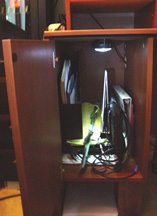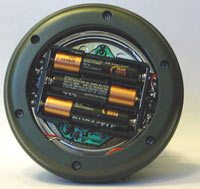There are always products that appear on the market which have an ingenious purpose and altruistically purport to resolve problems suffered by all. And we, the public (or at least me) brighten at the prospect of finally being able to fix this or that nagging issue from the good designers and engineers at company X, Y, or Z. The wireless auto-sensing “puck” LED Light (available through a variety of manufacturers) which turns on and off with no intervention from the owner, appears at first glance to fall into that mighty ilk.
Now the Puck Light is not a particularly exciting product. But, for folks with tiny houses (ahem), dark closets (ahem), and messy under-the-sink cupboards (ahem); and who are mechanically and electrically-challenged (double ahem); and who suffer from presbyopia or other such ocular maladies the Puck Light is as great an idea as is the boxed cake mix to the epicurean-challenged (ok ahem there too).
The concept is fairly simple and works in a manner similar to your refrigerator light: Place the Puck Light in an otherwise dark closet or drawer, open the door and the light goes on, close the door and the light goes off. No mechanical switches, no laser levels, no wiring is needed. Perfect for my tiny house and tiny nooks and crevices.

The magic mechanism used by the Puck Light is an optical or photo resistor. When enough ambient light in the room (“room light”) hits the photo resistor (by opening a door or drawer, for example), that room light triggers the rest of the circuit and the Puck Light is engaged. Closing the door shields the room light from the photo resistor and the circuit extinguishes the light. The room light passes to the photo resistor through a tiny window or hole in the side of the device (see arrow on Figure 1.).
The Puck Light is powered by three (replaceable) AA batteries and contains five LED “bulbs”. A switch allows you to set up the Puck Light in either the optical sensing mode (i.e. refrigerator mode); in a continuous (always on) mode; and in a somewhat-annoying click-n-make-brighter mode. There is a hole on the back of the unit to allow you to hang it on a nail and it also comes with an optional double-sided sticky Velcro pad for even easier installation. It is normally sold in a pack of three.

Using the Puck Light for the first time right out of the box is entertaining and educating; you can wave your finger over the optical resistor window and watch the light illuminate and douse itself. Yes, you think to yourself, this is a good thing. It will work. It would seem a beautiful and concise concept.
Concept to implementation, however, is quite a chasm. And such is the case with the Puck Light — read on.
As mentioned, there is a tiny window or hole that allows the room light to hit the photo resistor, which then engages the LEDs (or “bulbs”). But this hole is tiny. So tiny in actual use that actual use is actually nearly useless. I found that placing the Puck Light under my kitchen sink counter, for example, required me to try to bounce light from a mirror on the wall to try to hit the tiny hole-target on the gadget. If I opened the cabinet door in the morning there was enough ambient light in the room to trigger the Puck Light’s LEDs. If my dog walked between the mirror and the kitchen window, however, there was not enough room light to light the light. Alas. I then had a flash of genius and tried to widen the tiny hole of one of the other two units (a guinea pig puck light if you will) with a not-so-tiny drill bit, knowing that a larger hole will allow more room light in. After than illuminating idea no light ever shone from that guinea pig device again (my bad, but it was worth a try given the faith I had in the product)(**see footnote). So I had to resort to using my kitchen cupboard only in the mornings.
Besides this irritant, the capsule through which the batteries are replaced is bothersome to remove; it takes several attempts to line up the magical plastic rings on the back of the unit in order to gain ingress. So yet another nuisance. Finally, as with all “no installation tools required” gadgets, the double-sided sticky material is only sticky for so long. The unit then falls off the wall into the abyss of your kitchen cupboard. That is where mine is and has been for the past two months.
In summary, the Puck Light concept is ingenious, well thought out, and makes me want to put them into every closet of my house. But it is lying at the bottom of the kitchen cupboard and I can’t find it because it is so dark in there.
Footnotes:
(*) This photo was possible only by shining a flashlight onto the Puck Light in order to trigger the optical resistor. As you can see, this is a perfect place for such a light, but it requires more room light in order for it to work. So it doesn’t.
(**) Though widening the hole somehow rendered the entire circuit broken, testing the resistor itself with an Ohmmeter showed that it was still viable, so it is probably reasonable to believe that there may be issues when inserting the light in an agitating environment.
Gerber Gear 22-47162N Fast Draw Folding Assisted Opening Pocket Knife, Fine Edge, Black
$42.69 (as of December 20, 2025 18:01 GMT -05:00 - More infoProduct prices and availability are accurate as of the date/time indicated and are subject to change. Any price and availability information displayed on [relevant Amazon Site(s), as applicable] at the time of purchase will apply to the purchase of this product.)Gerber Gear EVO Jr. Folding Knife - Serrated Edge [22-41493]
$28.99 (as of December 20, 2025 18:01 GMT -05:00 - More infoProduct prices and availability are accurate as of the date/time indicated and are subject to change. Any price and availability information displayed on [relevant Amazon Site(s), as applicable] at the time of purchase will apply to the purchase of this product.)Product Information
| Price: | Varies among manufacturers; typically $10 each in a triple pack |
| Manufacturer: | Variety of manufacturers |
| Requirements: |
|
| Pros: |
|
| Cons: |
|



Gadgeteer Comment Policy - Please read before commenting
Perhaps the circuitry is tuned to the amount of light received through the original small hole and would have to be adjustable with a trimming var resistor or similar so that it is sensitive within the changed parameters. (More light from bigger hole).
Yep, that could very well be. Good point.